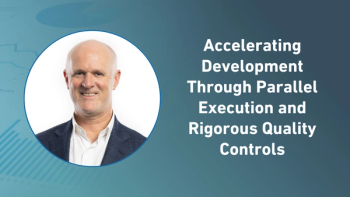
- Applied Clinical Trials-09-01-2021
- Volume 30
- Issue 9
Driving Clinical Speed and Agility Post-COVID
Improvements in data management and collaboration forge path to greater efficiency.
HG Wells said it best, “adapt or perish, now as ever, it is nature’s inexorable imperative.” In life sciences, change is happening out of necessity to navigate COVID-19 disruptions. The pandemic brought urgency to simplify processes and keep studies going, accelerating transformation across the industry. This is especially true in clinical data management, and CROs have been at the forefront.
By adopting digital strategies and technologies, CROs are embracing new ways of working to meet growing sponsor requirements and patient expectations. The improvements in collaboration and efficiency have proven what is possible, and now there is no going back.
As we get closer to a post-COVID-19 world, sponsors and patients will look for the same levels of speed and agility. CROs are prepared to take on the challenge by using agile study design and artificial intelligence (AI), incorporating data from remote data sources, and enabling connected clinical processes to accelerate trial execution.
Streamline data build
COVID-19 stopped or delayed more than 2,000 clinical trials,1 exposing potential points of failure in how trials are conducted. This is true in data management, where it takes approximately 72 days for monitors to conduct onsite source data verification (SDV) for a study.2 But as trials slowed down at the height of the pandemic, new COVID-19 treatment and vaccine studies presented an opportunity for CROs to innovate and complete trials faster than ever before.
With the industry’s success in bringing vaccines to market in much shorter periods, sponsors expect CROs to continue the momentum and deliver faster cycle times throughout the development process. One area with significant opportunity for improvement is study start-up, where EDC study builds take a mean cycle time of 69 days from protocol approval to database go-live.3 To improve the pace, CROs are using modern clinical data management systems (CDMS) that empower teams with agile study designs.
“We found a lot of innovation using agile study design, where we were able to set up COVID-19 trials in just a few weeks,” said Trevor Griffiths, director, clinical data management at Syneos Health. “To do this, we developed standards specifically for COVID-19 trials and worked hand in hand with our partners and
technology providers.”
Unfortunately, protocol changes—which were exceedingly common in COVID-19 trials—are the top cause of build delays. In today’s climate, sponsors expect to see these changes handled quickly and efficiently. Month-long delays, manual processes, and inflexible systems are no longer acceptable, especially for mid-study changes. More CROs are adopting CDMS to eliminate downtime when making amendments, regardless of the visits and rules impacted.4
Accelerate data cleaning
The use of new external data sources in trials increased during the pandemic, presenting numerous challenges for data managers. The industry is already embracing sources like real-world evidence or wearables. With studies shifting from the clinic to patient homes, alternative means of gathering data are rising. This change exacerbates the downstream issues of incorporating diverse data sets, increasing the need for solutions to manage data from disparate sources.
Cleaning remains a challenge since it requires the review of a growing volume of data points. More CROs are looking for scalable, flexible technology to accelerate the process.
“COVID-19 kickstarted the use of AI for data cleaning, especially because we were working on massive vaccine trials with tens of thousands of subjects,” added Griffiths. “We were able to successfully train and program AI, nearly eliminating manual review of medical data.”
Today’s data aggregation tools, analytics solutions, and pre-built integrations are essential to making this a reality. “Externally, a connected approach addresses the issues of multiple sources for data but working with different functions internally requires having a strong workbench,” said YaFang Wu, senior director, Parexel. “By using both, you’re able to manage different information and paths altogether, in one single area.”
Applying data workbench and AI strategies will help data teams perform rapid data cleaning and accelerate lock times.
Remote data sources
The increased adoption of decentralized approaches represents a positive development in the industry, and CROs are leading the charge to enable a more patient-centric, digital clinical trial. For example, using applications for eConsent or electronic patient-reported outcomes (ePRO) allows researchers to collect and record patient consent and clinical data digitally, making it easier to review, share, and report information.
“With limited access to research sites, we quickly had to adapt and implement a more patient-centric approach to bring trials to the patient,” said Sam Ryan, director of data management at ICON. “We expect this trend will remain beyond COVID-19 to assure flexibility for patients, meaning an increase in home visits, more technology, and an explosion of data.”
Leveraging decentralized approaches reduce the patient burden of participating in trials and ease the administrative burden on research sites. For CROs, the increase of patient information sources added complexity in managing the data produced during the trial.
“The explosion of data driven by decentralized approaches, like wearables and sensors, presents an opportunity to reimagine the data manager. Making roles more technical and data science-focused can ensure companies have the people to set up, oversee, and manage each interconnection and data source in a trial,” added Ryan.
CROs are evolving their infrastructure for greater oversight and control. With the right systems and people in place, they can ensure accurate data, manage change proactively, and accelerate trials.
Bringing together data and ops
As shown in Figure 1 below, CROs are advancing toward unifying their clinical systems for better visibility and oversight (70%), reduced manual processes (69%), and improved study quality (60%). A big part of achieving those improvements is connecting clinical data and trial management systems to automatically exchange new records and updates to existing subjects quickly and easily.
With an integrated approach, shown in Figure 2 below, pharma companies and CROs can streamline processes like remote monitoring, allowing clinical research associates to seamlessly navigate from monitoring visits to subject case books for SDV. Bringing together data and operations increases cross-functional efficiency and visibility, enabling leaders to proactively manage studies and identify issues early on.
A unified approach to clinical automates data transfers, eliminating the need for duplicate data entry and, in turn, reducing transcription errors. With a single log-in, study teams can access real-time patient enrollment and status information to speed study start-up, a critical area that accounts for 61% of total trial cycle times.5
Faster, nimbler trials
Life sciences is especially adept at identifying problems, putting together new formulas, and applying learnings. COVID-19 placed the industry on a steep curve, and the lessons coming out of it have improved clinical trial processes.
Sponsors and CROs have enabled more connected ways of working in studies powered by agile digital solutions. Whether onsite, decentralized, or hybrid, tomorrow’s trials will be conducted in a way that is most convenient to sites and patients and will be executed by teams who have brand new skillsets. The shift is long overdue.
References
- Berlin Institute of Health, Clinical Trials Stopped by COVID-19, 2021
- Applied Clinical Trials, Risk-Based Monitoring Versus Source Data Verification, 2018
- Tufts CSDD, Impact Report, Volume 23, Number 2, March/April 2021
- Veeva Systems, Bioforum The Data Masters interview, 2021
- Tufts Center for the Study of Drug Development Impact Report, Clinical Site Initiation Process Remains Lengthy and Highly Inefficient, 2018
Sid Mohamoodally, Senior Director, Strategy, Vault CDMS, Veeva Systems
Articles in this issue
about 4 years ago
A Look Back: How Far Clinical Trial Technology Has Comeabout 4 years ago
Sample Size Re-Estimation as an Adaptive Designabout 4 years ago
Building Relationships Key for Smaller Sponsorsabout 4 years ago
Rebadging Gains Momentum Amidst COVIDabout 4 years ago
The Post-Pandemic CRO Landscapeabout 4 years ago
Amplifying Patient Voices in Protocol Designabout 4 years ago
The State of IRT and RTSM Technologiesabout 4 years ago
Rhetoric and Realism Colliding on EU Discussions of Drug Repurposingabout 4 years ago
Could Technology Supplant CROs?about 4 years ago
Applied Clinical Trials September 2021 Issue (PDF)Newsletter
Stay current in clinical research with Applied Clinical Trials, providing expert insights, regulatory updates, and practical strategies for successful clinical trial design and execution.






.png)



.png)



.png)
.png)
